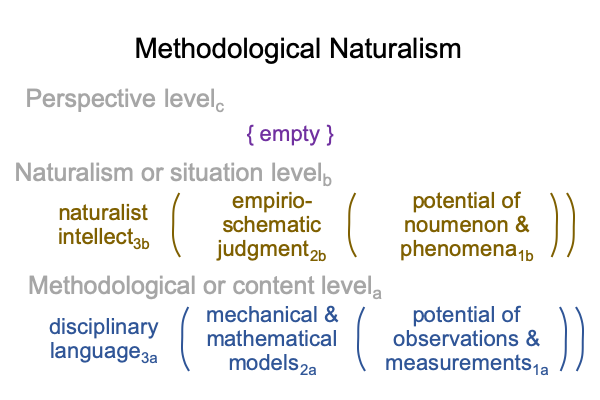0026 In 1981, the ship, The Creation Science, encounters the leviathan swimming in the celestial waters. The captain loses a leg to stand on, but realizes that he can fashion a new leg even better than the first. He repairs the ship and re-brands her, The Intelligent Design. In 2005, this ship lures the leviathan down from its heavenly deep, once again.
In this interval, philosopher Larry Laudan vigorously attacks the foundation of the leviathan’s first victory. He pulls teeth. He demolishes the argument that science and religion may be distinguished on the basis of method.
Finally, The Intelligent Design opens sail with a methodology identical to the empirio-schematic judgment and coherent with its content-level nested form. The normal context of disciplinary language3a, describing methods, brings the actuality of metaphysically-open models2a into relation with the possibilities inherent in observations and measurments1a.
0027 Once again, here is the two-level interscope for methodologicala naturalismb.

0028 Pennock wants to defend the demarcation of science and religion. Method does not offer sufficient critieria. So, he configures a new foundation. He calls it “methodological naturalism”. But, the “methoda” has already been neutralized by Laudan. So, “naturalismb” is the key.
To this end, in section 5 of this article, Pennock constructs a weak version of the distinction between science and religion, one that grants many of Laudan’s points. Tellingly, instead of referring to the ship’s new name, The Intelligent Design, Pennock sticks to the old label, The Creation Science.
Pennock writes four sub-sections (O-R).
0029 The first (O) concerns the dustbin of history.
Creation Science is not even a bad science. For example, some say that the Earth is only a few thousand years old. Others say that Noah’s Flood is global. These models are not supported by data.
0030 The second (P) concerns disciplinary language.
The ship, The Creation Science, has no coherent disciplinary language, outside of Biblical interpretation. The language of Intelligent Design is also incoherent. Even if one observes phenomena associated to impossible events, one cannot conclude that the events are miraculous.
Okay, one can conclude that the events are miraculous. But, that would violate the rules of the naturalist intellect3b.
0031 The third (Q) is pragmatic.
Methodological naturalists recognize science. Why can’t philosophers like Laudan? Why are courses on the philosophy of science not taught by theologians?
What do the sailors on The Intelligent Design hear?
Someone in the waters asks, “Why are courses on the philosophy of religion not taught by scientists? Er… I mean… taught by highly certified naturalists who self-identify as ‘not religious’?”
Oh, never mind, they are.
0032 The fourth (R) is empirical.
Science educators say that there is a real distinction between science and non-science, such as Creation Science. The National Science Teacher’s Association insists that scientific claims are not religious.
Or, should I say that the empirio-schematic judgment is not religious?
What about “scientific” or methodological naturalism?
Is that not religious?
Of course, the rule of naturalism says, “No metaphysics.”
Who is surprised that no mechanical or mathematical models appeal to supernatural forces?
Pennock finally feels the sharp point of an issue that cannot be confronted. He states that his account explicates “scientific” naturalism as a methodological commitment, not a metaphysical one. The ground rule of “no metaphysics” is… um… not metaphysical.
0033 Say what?
What is the philosopher’s task?
Is it possible for a philosopher to accept that the claim to be “not religious” may, indeed, be not religious?
Since when do philosophers spout tautologies?
Take a glance, once again, at the two-level interscope for methodological naturalism.
There is a certain circularity to the structure. The content-levela is the empirio-schematic judgment. The empirio-schematic judgment is the actuality2 of the situation levelb.
0034 Where does the ground rule of “no metaphysics” come from?
Does it come from inside the circle?
Does it come from outside the circle?
Why is the perspective level empty?
What does that imply?
